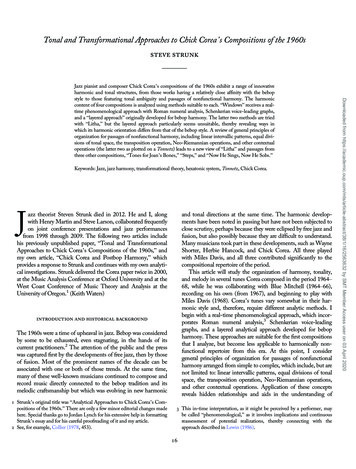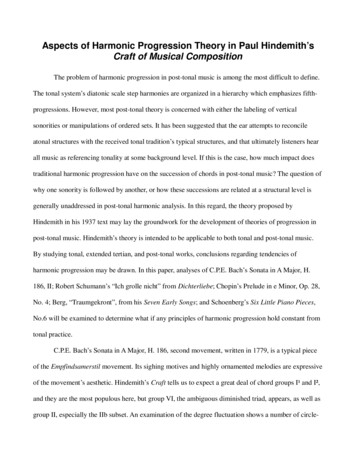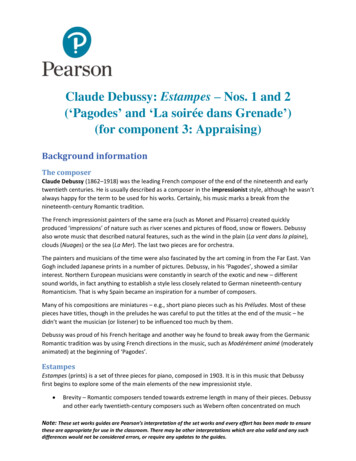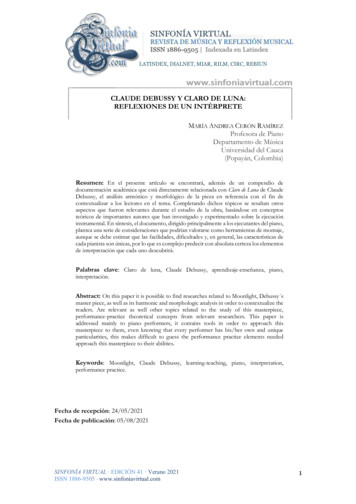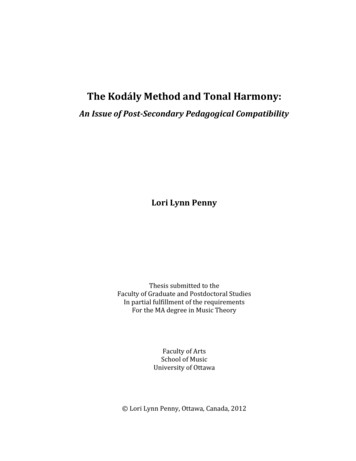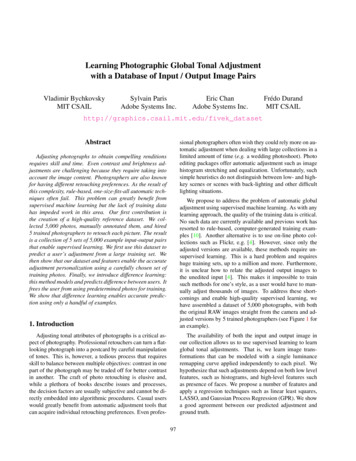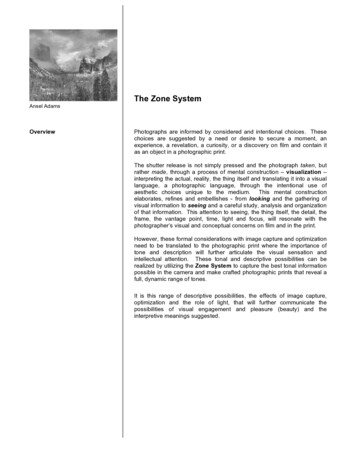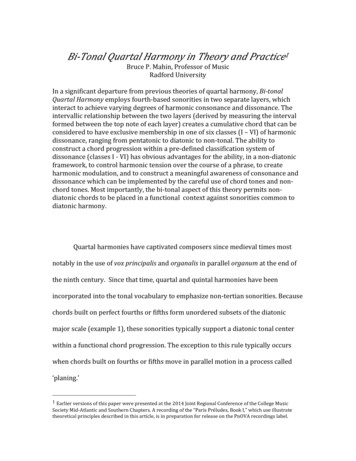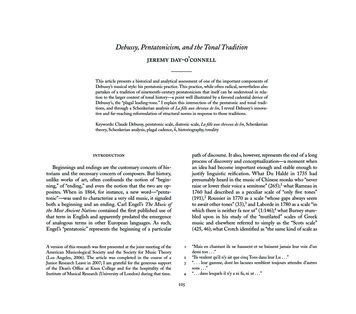
Transcription
MTS3102 0111/10/0912:23 PMPage 225Debussy, Pentatonicism, and the Tonal Traditionjeremy day-o’connellThis article presents a historical and analytical assessment of one of the important components ofDebussy’s musical style: his pentatonic practice. This practice, while often radical, nevertheless alsopartakes of a tradition of nineteenth-century pentatonicism that itself can be understood in relation to the larger context of tonal history—a point well illustrated by a favored cadential device ofDebussy’s, the “plagal leading-tone.” I explain this intersection of the pentatonic and tonal traditions, and through a Schenkerian analysis of La fille aux cheveux de lin, I reveal Debussy’s innovative and far-reaching reformulation of structural norms in response to those traditions.Keywords: Claude Debussy, pentatonic scale, diatonic scale, La fille aux cheveux de lin, Schenkeriantheory, Schenkerian analysis, plagal cadence, 6, historiography, tonalitypath of discourse. It also, however, represents the end of a longprocess of discovery and conceptualization—a moment whenan idea had become important enough and stable enough tojustify linguistic reification. What Du Haldé in 1735 hadpresumably heard in the music of Chinese monks who “neverraise or lower their voice a semitone” (265);1 what Rameau in1760 had described as a peculiar scale of “only five tones”(191),2 Roussier in 1770 as a scale “whose gaps always seemto await other tones” (33),3 and Laborde in 1780 as a scale “inwhich there is neither fa nor ut” (1:146);4 what Burney stumbled upon in his study of the “mutilated” scales of Greekmusic and elsewhere referred to simply as the “Scots scale”(425, 46); what Crotch identified as “the same kind of scale asintroductionBeginnings and endings are the customary concern of historians and the necessary concern of composers. But history,unlike works of art, often confounds the notion of “beginning,” of “ending,” and even the notion that the two are opposites. When in 1864, for instance, a new word—“pentatonic”—was used to characterize a very old music, it signaledboth a beginning and an ending. Carl Engel’s The Music ofthe Most Ancient Nations contained the first published use ofthat term in English and apparently predated the emergenceof analogous terms in other European languages. As such,Engel’s “pentatonic” represents the beginning of a particularA version of this research was first presented at the joint meeting of theAmerican Musicological Society and the Society for Music Theory(Los Angeles, 2006). The article was completed in the course of aJunior Research Leave in 2007; I am grateful for the generous supportof the Dean’s Office at Knox College and for the hospitality of theInstitute of Musical Research (University of London) during that time.1234225“Mais en chantant ils ne haussent et ne baissent jamais leur voix d’undemi ton . . .”“Ils veulent qu’il n’y ait que cinq Tons dans leur Lu . . .”“. . . leur gamme, dont les lacunes semblent toujours attendre d’autressons . . .”“. . . dans lesquels il n’y a ni fa, ni ut . . .”
MTS3102 0122611/10/0912:23 PMPage 226music theory spectrum 31 (2009)that produced by the black keys of the piano-forte,” (quotedin Crawfurd 1820/1967, 339) and Fétis as “a tonal system inwhich the semitone frequently disappears” (1849, xxi): in1864 these became, once and for all, “the pentatonic scale.”The scale Engel christened “pentatonic” would much latercome to be associated with certain composers in theEuropean tradition, above all with one who was himselfchristened that very year. On July 31, shop-keepers Manueland Victorine Debussy baptized their first child, babyAchille-Claude, and soon thereafter sold their china shopand left their home in Saint-Germain-en-Laye, ultimatelysettling in Paris. For the composer, of course, these eventsmarked (unambiguously) the beginning of a life; a composer’s work, on the other hand, exists within history, andthe historian who contemplates this work enjoys a more flexible perspective. Debussy the critic clearly appreciated suchhistoriographic subtleties when he assessed Wagner as “abeautiful sunset that was mistaken for a sunrise” (1988, 82).In this article I will consider Debussy himself as bothsunset and sunrise by examining his music with respect tonot only pentatonic history but also to the history of diatonictonality—in particular, the device I call the “plagal leadingtone.” In the end, and with a little help from HeinrichSchenker, I will demonstrate the richness of Debussy’s response to those histories in the form of his piano prelude Lafille aux cheveux de lin.And since the sunset/sunrise distinction (whether meteorological or music-historical) can only be discerned in context, I will briefly mention, by way of foreshadowing some ofmy case studies, the varied and fertile context of Debussy’slife as a musician, critic, and composer: his early studies withMadame de Fleurville, a purported pupil of Chopin; his employment under Tchaikovsky’s devoted patroness, Nadezhdavon Meck in 1880 and his subsequent trip to Russia; hisfond visit with Liszt in Rome; the troubled but hopeful stateof French music at the time, and Debussy’s high regard forFrench composers of years past; his infatuation with themusic of Wagner, who, even after that infatuation turnedsour, exerted an inescapable presence that Debussy referredto as “the ghost of old Klingsor” (1987, 54); and, of course,that celebrated event a quarter century after the doublechristening just described: the 1889 Paris Exhibition.the pentatonic tradition: literate europeanpentatonicism, the first hundred years“We can hardly overestimate the impact made onDebussy at this still formative period by the revelation of thisentirely novel exotic music.” So writes Edward Lockspeiser(1962, 113), on Debussy’s attendance at the 1889 Exhibitionand the “exotic” sounds of the Javanese gamelan andVietnamese theatre. According to Debussy’s friend RobertGodet, “Many fruitful hours for Debussy were spent in theJavanese kampong of the Dutch section listening to the percussive rhythmic complexities of the gamelan with its inexhaustible combinations of ethereal, flashing timbres” (quotedin Lockspeiser 1962, 113). The music of 1889 would, yearslater, arouse wistful reminiscences in Debussy’s writings, andone piece—Pagodes, from the piano collection Estampes—would bear the gamelan’s unmistakable influence even at theremove of over a decade. Pagodes is certainly Debussy’s mostsustained and ambitious pentatonic effort, exemplary for itssubtle, atmospheric use of pentatonicism. It demonstrates anearnest engagement with the purely musical possibilities ofthe pentatonic scale, notably through manipulation of pentatonic subsets, supersets, and transpositions. David Kopp(1997) has detailed the almost minimalistic shifts of pitchcontent throughout the piece, gradual additions to and deletions from a pervasive B-pentatonic scale (277–83). I willonly mention here how Debussy—as “sunrise”—exploits thepentatonic scale’s set-theoretic attributes in idiosyncraticways that counteract an otherwise ostensibly tonal surface.The pentatonicism of Pagodes’ opening texture, shown inExample 1(a), is divided between the tonic triad of the lefthand and a tetratonic melodic motive. That tetrachord (setclass 4-23[0257]) is a favorite infra-pentatonic resource of
MTS3102 0111/10/0912:23 PMPage 227debussy, pentatonicism, and the tonal tradition(a) mm. 3–4 délicatement et presque sans nuances 3227 rit. (b) mm. 23–24Toujours animé 23 (c) mm. 27–29revenez du 1o Tempo27 (laissez vibrer) que possible aussi (d) endretenu97 example 1. Debussy, Pagodes (1903)
MTS3102 0122811/10/0912:23 PMPage 228music theory spectrum 31 (2009)Debussy’s, one that avoids the sweetness and triadic-tonal associations of the major third but instead features the austereintervals of the second and fourth. The varied return of thismaterial at measure 23 (given in Example 1[b]) at first appears to offer a pentatonically “complete” rendition of themelodic material, as all five tones are present in the uppervoices. However, a closer look reveals a juxta- and superposition of two intervallically identical tetrachordal sets (the original 2/3/5/6 along with 1/2/5/6), a result of the canonic treatment of the theme. The tetrachord’s stark intervallic contentis made most explicit in the codetta to the first main section(measures 27–9), the tetratonic theme in Example 1[c],which is accompanied by familiar Debussian “organum”: theresulting counterpoint in parallel “thirds” (i.e., 2/5, 3/6, 5/2,and 6/3) contains only perfect intervals. (A fully pentatonicorganum of this sort would contain a single major third, 1/3,beside its four perfect fourths—a perhaps overly differentiated interval structure for Debussy’s purposes.5) Similar pentatonic fragmentation continues throughout the piece, whichmakes the dissonant (i.e., ostensibly unresolved) final sonority, provided in Example 1(d), all the more striking: the lastmeasure simply freezes the ubiquitous pentatonic figuration,and it is this stillness (emphasized by the indication laissez vibrer) that quietly invites the listener at last to truly behold thepentatonic set as one complete entity.Not only the pitch material of Pagodes, but its counterpoint, shimmering figuration, and title all suggest, asConstanin Brailoiu wrote in his extensive (albeit error-ridden) essay on Debussy’s pentatonicism, “a distinct categorygenerated in the atmosphere of the World Exhibition”(1959, 390).6 Nevertheless, no other piece in Debussy’s oeuvre contains the same combination of pentatonicism and exoticism. As it happens, scholars have questioned the facile56It is precisely the differentiation of intervals in a scale that contributesthe tonal principle of “position-finding” (Browne 1981, 7).Brailoiu (1959), for instance, cites several instances of pentatonic “mutation” in Debussy, though none are convincing to me, and two areascription of Debussy’s pentatonic style to a supposedepiphany at the Paris Exhibition. Indeed, pentatonicism canbe heard in music Debussy composed before 1889. RichardMueller (1986) has argued that Debussy’s prior knowledgeof both the pentatonic and whole-tone scales prepared himto hear (and to remember) certain elements of those Javaneseperformances (160–61). Even Brailoiu admits that 1889 wasnot the beginning of the composer’s apparent acquaintancewith the scale (1959, 413). What’s more, Debussy expresseda wry skepticism toward musical exoticism in any case.7What most scholars have failed to appreciate, however, isthe true extent of pentatonic practice in the Western tonaltradition before Debussy. Numerous earlier practitioners ofpentatonic exoticism might be mentioned, including Weberand Kalkbrenner (both using borrowed material), andDebussy’s elder contemporaries Offenbach and Saint-Saëns:compare Example 2 and Example 1(a). And exoticism accounts for only one part of the “pentatonic tradition.” In theaforementioned, pentatonically momentous year of 1864,for instance, Gounod’s Mireille premiered to the sound of apentatonic shepherd’s call, given in Example 3. One day,Gounod would hear a similarly pentatonic opening as a jurorat the Académie des Beaux-Arts (along with Saint-Saëns),charged with assessing Debussy’s Prix-de-Rome envoi, thesymphonic suite Printemps: compare Examples 3 and 4.878plainly wrong: Brailoiu’s excerpt from “Soupir” ends in mid-phrase,omitting notes that weaken his point; his excerpt from “La Cathédraleengloutie,” meanwhile, contains a misprint (411–13) (in fact, Debussy’soriginal does not include the purported mutation).Not long after the Paris Exhibition, Debussy is said to have rejectedLakmé as “sham, imitative Oriental bric-à-brac” (quoted in Lockspeiser1962, 208). Years later, Debussy criticized others of his contemporaries:“Rather than drawing upon any instinctive ingenuity within themselves, they dig up ideals whose foundations were laid in the Stone Age,or serve up crude imitations of Javanese music. There’s nothing eithernew or astonishing about that” (quoted in Debussy 1988, 265).The assessment of the Académie was, famously, negative, thoughGounod himself is said to have defended the work (Nichols 1998, 42).
MTS3102 0111/10/0912:23 PMPage 229debussy, pentatonicism, and the tonal traditionFl. IFl. IITri. 229 example 2. Saint-Saëns, Marche Orient et Occident (1869), 3 measures before rehearsal 4Andante example 3. Gounod, Mireille (1864), Overture, beginningTrès modéré 9 8 example 4. Debussy, Printemps (1887), i, beginning
MTS3102 0111/10/0912:23 PMPage 230230music theory spectrum 31 (2009) 3 4 34 example 5. Vogler, Pente chordium (1798), beginningmovements on such popular songs as “The Yellow Hair’dLaddie”—as well as of Beethoven and Haydn, who gladlyharmonized a large number of Scottish songs for an insatiable public. Newly composed Scottish-style pentatonicismappears in music throughout the nineteenth century, including in Berlioz, Mendelssohn, Loewe, and Brahms. The pentatonicism of Debussy’s piano prelude La fille aux cheveux delin (which I will discuss in depth later) calls to mindDebussy’s earlier, unpublished mélodie of the same name,which set poetry from Leconte de Lisle’s Scottish Songs.10Another category of pentatonicism (unmentioned by thewriters cited above, but alluded to by Riemann), the “religious pentatonic,” figured prominently in Liszt’s sacred (andsacred-inspired) music.11 Pentatonic passages in Debussy’sLe Martyre de Saint Sébastien suggest certain correspondences with Liszt’s St. Elisabeth (compare Examples 6 and 7)as well as with Wagner’s Parsifal (compare Examples 8 and 9).As I describe below, the religioso coda in Berlioz’s Symphoniefantastique may have exerted a lasting influence on themelodic vocabulary of nineteenth-century composers, notleast of all Debussy.Finally, it might be supposed that a further, non-signifying brand of pentatonicism—as it were, “coloristic” pentatonicism—is more uniquely Debussian. But this isn’t entirelyright either: pentatonic and added-sixth flourishes enlivenedthe tonic triads of Chopin, Liszt, and Thalberg (whoseThe scope of the pentatonic tradition can be further appreciated by considering that F -pentatonic theme: neitherDebussy, nor Chopin before him (recall Chopin’s Etude inG , op. 10, no. 5), was the first to discover the peculiarlypleasing sound so unassumingly contained in the blackkeys of the piano. As early as 1798, Abbé Georg-JosephVogler (though surely not the first himself ),9 composedan all-black-key piece entitled simply, and enigmatically,Pente chordium (given here in Example 5), what I can onlyguess was an attempted allusion to ancient Greek music.(Debussy’s first Épigraphe Antique, “Pour invoquer Pan, dieudu vent d’été,” makes a similar allusion, as well as a typicalconflation of the pastoral with the primitive.)Debussy would have no doubt noticed the scalar commonality of Asian and Scottish music, which Engel called“quite inexplicable” (1864/1909, 128). And though theScottish influence on Debussy is seldom considered, he wasindeed susceptible to this northerly exoticism (as it were).The musical borrowing in Debussy’s Marche écossaise sur unthème populaire follows the practice of, for instance, J.C.Bach, whose opus 13 keyboard concertos featured variation9We have, for instance, a letter from Robert Burns who recounts a sortof pentatonic party trick: “Mr. James Miller . . . was in company withour friend [Stephen] Clarke; and talking of Scotch music, Mr. Miller expressed an ardent ambition to be able to compose a Scots air. Mr. Clarke,partly by way of joke, told him to keep to the black keys of the harpsichord,and preserve some kind of rhythm, and he would infallibly compose aScots air.” Letter from Burns to George Thomson (November, 1794)quoted in Johnson 1972, 188.1011For a discussion of the two pieces, see Briscoe 1981.Riemann (1882/1965, 279) mentions the pentatonicism of Gregorianchant.
MTS3102 0111/10/0912:23 PMPage 231debussy, pentatonicism, and the tonal traditionLa voix de la vierge erigone 4Jefau - chais l’E - pi de fro - ment, ou - bli - eu 231 -se de l’as - pho - ! example 6. Debussy, Le Martyre de Saint Sébastien (1911), II/2, measures 4–6 example 7. Liszt, St. Elisabeth (1862), “Miracle of the Roses”century pentatonicism, its genesis, its conceptual underpinnings, and the various interconnections among its severalstrands.12 For now, I will simply note that the music I havecited here represents only a small sampling from a surprisingly extensive, even convoluted history.13“Fantasy on Il Trovatore” is quoted in Example 10), to saynothing of the English harp virtuoso Elias Parish-Alvars,who in the 1830s apparently pioneered the pentatonic harpglissando (Example 11), so characteristic of Debussy’s orchestral music.***In this quick survey of the pentatonic tradition, I havenoted many correspondences and connections, but ultimately I am concerned less with proving specific influencethan with calling attention to a vast body of repertoire anda broad historical span, in which pentatonic techniques canbe seen. Much more could be said regarding nineteenth-1213For this, see Day-O’Connell (2007).This history extends back to the early eighteenth century. One of thefirst relevant examples I have found occurs in a Handel aria, “CaroAmor” (from Il pastor fido), which begins with a simple pentatonic invocation by Mirtillo, the “faithful shepherd” of Guarini’s pastorale. Itspentatonicism is, to be sure, incidental to an ultimately triadic melodicdesign, a quality that it shares with many other examples.
MTS3102 0111/10/0912:23 PMPage 232232music theory spectrum 31 (2009) " # -le Al-lu- le --le- lu AlAl -lu-ia. - cresc. Al- le ia. Al-lu -le -- "Al-lu #ia. "le-lu-ia. -ia."ia. cresc. example 8. Debussy, Le Martyre de Saint Sébastien, V, 9 measures from end """" % % % % % % example 9. Wagner, Parsifal (1881), I, endTo recognize this history is not to minimize Debussy’sundeniable contribution. But the composer of such extraordinary pentatonic works as Pagodes, Voiles, and Les collinesd’Anacapri must not be perceived as only a “sunrise,” when somuch of his pentatonic output suggests such strong connections with tradition. At the same time, however, connectionswith tradition do not necessarily render a composer “traditional”; the rest of my article is motivated by this awareness.
MTS3102 0111/10/0912:23 PMPage 233debussy, pentatonicism, and the tonal traditionAndante233 3 8 &&&&&&leggerissimo 3 8 example 10. Thalberg, Fantasy on Il Trovatore, op. 77 (1862), beginning sdrucciolando ' ' ( (E ),,,' ' ' ' ), , ,' ' '' ,' ' ff (A ) example 11. Parish-Alvars, Serenade, op. 83 (1846), end
MTS3102 0123411/10/0912:23 PMPage 234music theory spectrum 31 (2009)or decoratively, or else is accompanied by fully diatonicchords.15Yet as F. A. Gevaert wrote in his widely read Traitéd’harmonie théorique et pratique (among the first significantdescriptions of pentatonicism in France), “pentaphonicmelodies [can be] associated with a completely heptaphonicharmonization without losing their scent of suave tranquility” (1905, 61).16 Indeed, as we will see later, the musicallanguage of La fille is too hastily dismissed as “so-called‘pentatonicism’”; rather, it depends precisely on a flexible interplay between the pentatonic and the diatonic, one that isfacilitated by the inherent relationship between those twosystems. The nature of that relationship has been alluded toabove but will be more properly introduced now; its statuswith respect to Schenkerian theory will be explored later.Again, the pentatonic scale, as commonly understood byWestern musicologists, coincides with a subset of theWestern major scale, as shown in Example 12: 1–2–3–5–6.(It differs in this regard from the octatonic and whole-tonescales, with which it is so often unthinkingly associated.)Scale degrees 4 and 7 are thus absent, along with the melodicsemitones and the harmonic tritone that they normally entail. Consequently, as Engel himself pointed out, “On theother hand there are two minor thirds which in our diatonicscale do not occur, viz., from the third to the fifth, and fromthe sixth to the octave” (1864/1909, 15).Engel’s observation is crucial, though it bears refining: theminor third, 3–5, in fact forms a structural element of classicalthe tonal tradition as pentatonic:the plagal leading toneHaving considered Debussy’s place in the pentatonic tradition, I wish to return momentarily to Carl Engel, whoseterm “pentatonic” likewise participated in a tradition, albeitone more of scholarship than of sound. A newly coinedword is a sort of gift to a scholarly community, but all thesame, something is lost the moment thought is concretizedand thus constricted. Indeed, I feel that the poverty of conventional accounts of nineteenth-century pentatonicism canbe partly blamed on the very existence of that term, “pentatonic,” and its ostensible transparency. After all—and asEngel’s predecessors (quoted earlier) remind us—“pentatonic” connotes more than its etymological literalism (“fivetoned”).This is no doubt true of most terms (certainly “diatonic”),but especially so in the case of a “marginal” musical materialthat is inevitably interpreted with respect to prevailingnorms. As David Kopp (1997) writes,The standard model for pentatonic music operating within a diatonic framework entails a single anhemitonic pentatonic scaleoverlaying diatonic scale degrees 1, 2, 3, 5, 6. This collection isused as the basis for melody, while the remaining diatonic pitchesare supplied by subsidiary lines or chords, facilitating full-fledgedpresence of the common tonal functions. Familiar instances ofthis technique underlying entire pieces are Chopin’s black keyetude (op. 10, no. 5) and Debussy’s prelude, La fille aux cheveux delin. These so-called ‘pentatonic’ works take place within a relatively conventional tonal context (263).14Kopp’s point accurately describes pentatonic music throughout the nineteenth century, including those passages I’ve citedabove, in which pentatonicism is expressed monophonically14Pomeroy (2003) similarly writes that the “true nature” of the pentatonicscale, even in Debussy, “resides in decorative embellishment of the tonictriad” (159).1516Even Vogler’s Pente chordium (given in Example 5), despite its completerestriction to the pentatonic scale, strongly implies a diatonic framework in the many dominant chords and authentic cadences that are expressed by its simple two-part texture.Gevaert was describing Wagner’s “Valhalla” motive, the first fourscale-degrees of which, incidentally, correspond to the beginning ofDebussy’s La fille. He mentions other pentatonic passages in Wagner,as does Lenormand (1915/1940, 87). On Wagner and Debussy, morebelow.
MTS3102 0111/10/0912:23 PMPage 235debussy, pentatonicism, and the tonal tradition 1 2 3 1 2 3 4 5 6! 8 5 6 7 8 leading tone”: “plagal” because of its harmonization in thecontext of a plagal cadence, and “leading tone” because of itsresolution upward to the tonic note. The plagal leading tonewas a significant innovation in the history of tonal melody:plagal cadences before about 1830 strictly observed scaledegree tendencies, with step-wise or oblique voice leading(6–5 or 4–3 or 1–1). One of the earliest uses of a “thirdwise” plagal leading tone (6–8) occurs in a work long hailedfor its innovations in other domains, and one that Debussyacclaimed as “the perfect masterpiece of romantic ardor”(1988, 266): Berlioz’s Symphonie fantastique (Example 13).The plagal leading tone thus corresponds to the mostcharacteristic aspect of the pentatonic scale—the subtonic 6.It nevertheless involves only two of that scale’s requisite fivetones; moreover, its harmonization generally entails 4 in alower voice, a note strictly foreign to the pentatonic scale.For these reasons, I consider the plagal leading tone to be(for lack of a better word) “pentatonic-ish”: a marginal diatonic technique that is strongly reminiscent of a central pentatonic technique. This conceptual overlap, so awkwardlyconveyed in words, is better represented schematically, as inExample 14, which includes both “classical” and “non-classical” (i.e., expanded) strands of the tonal tradition. In thusidentifying a point of contact between the plagal leadingtone and pentatonicism per se, however, I make no claims ofhistorical priority, much less of “cause” or “effect” (suchclaims are, after all, scarcely provable). Suffice it to say thatthe two techniques are structurally similar; for a composer example 12. The pentatonic scale compared to the major scalediatonic tonality, comprising as it does two notes of the (stable) tonic triad. The pentatonic scale’s other minor third,however, does present a melodic anomaly: in the absence ofthe leading tone, scale degree 6 assumes special prominenceand stands in a “stepwise” relationship to the tonic in addition to its straightforward classical role as the upper adjacency to 5. This strangely “subtonic” 6—what one Dvořákscholar has ironically referred to as the “problem” of pentatonic 6 (Beveridge 1977, 33–34)—may or may not be exploited in a given pentatonic piece. Nevertheless, as a structural feature, it is the single most “marked” element (in termsof melodic motion, arguably the only “marked” element) ofthe pentatonic scale, vis-à-vis the major scale.All the same, diatonic tonality itself adopted various expansions of melodic practice in the course of the nineteenthcentury, including relaxations of classical stepwise scaledegree tendencies. Importantly for the present discussion,6 came to be used in a way that suggests the term “plagalreligioso 6 ' . 8 235 6 8 )example 13. Berlioz, Symphonie fantastique (1830–32), i, end
MTS3102 0111/10/0912:23 PMPage 236236music theory spectrum 31 (2009)Diatonic7ˆ – 8̂6ˆ – 5ˆPentatonicExpanded19th-CenturyDiatonic3ˆ – 2ˆ – 1ˆ3ˆ – 5ˆ6ˆ – 8ˆ4ˆ – 3̂example 14. Melodic possibilities in diatonic and pentatonic usage: the plagal leading tone as a marginal diatonic techniquethat is strongly reminiscent of a central pentatonic techniquesuch as Debussy, who was demonstrably conversant withboth, those structural similarities would inevitably interact inthe musical imagination (albeit at some subconscious level).(The analyst who is likewise conversant with both techniques will appreciate the key-defining nature of the unaccompanied pentatonic theme of Debussy’s Les collinesd’Anacapri, which Kopp [1997], inattentive to its plagalleading tone, declares tonally ambiguous [266].17)17The 6–8 with which this theme ends is, admittedly, hardly a straightforward example of a plagal leading tone: it is unaccompanied; it ismetrically awkward (at least as far as Debussy’s notation is concerned,for what that’s worth barely a measure into the piece); and thetheme’s five notes are all held, producing a dissonant pentatonicsonority rather than a cadential tonic. Nevertheless (and compellingthough Kopp’s “soft pentachord” is in the remainder of his analysis),it is difficult not to hear the harmonic implication of the arpeggiatedsupertonic, 2–4–6–8, which resembles several (un-ambiguous) cadences discussed below (and which does, it must be said, confirmwhat emerges as the key of the piece). The “sunrise” that Kopp celebrates needn’t blind us to the tonal tradition that underlies this andother aspects of the piece.To put it another way: while analysts naturally gravitatetoward the clearest examples of a phenomenon, I believe itwould be wrong to take such examples as most representative of the act of musical composition. In assessing Debussy’spentatonic sensibility, we must consider the broader traditionof tonal harmony and melody, in addition to the pentatonictradition per se (broad though it is in its own right, as we’veseen). After all, when faced with a blank sheet of staff paper,composers do not normally reach for the textbook, whetherreal or figurative—least of all Debussy, who so scorned academicism—but draw upon a lifetime of musical experienceand a set of organically formed intuitions concerning thelanguage of tone. In pointing out the similarity between thepentatonic scale and the plagal leading tone, I intend toquestion the ostensibly uncontroversial distinction betweenpentaton
engloutie," meanwhile, contains a misprint (411-13) (in fact, Debussy's original does not include the purported mutation). 7 Not long after the Paris Exhibition, Debussy is said to have rejected Lakmé as "sham, imitative Oriental bric-à-brac" (quoted in Lockspeiser 1962, 208). Years later, Debussy criticized others of his .


